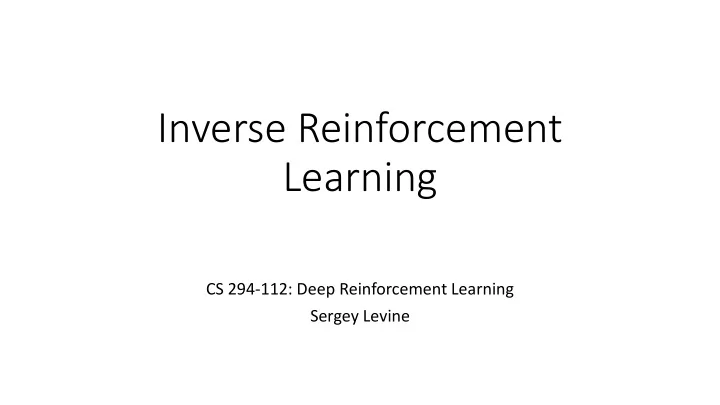

Inverse Reinforcement Learning CS 294-112: Deep Reinforcement Learning Sergey Levine
Today’s Lecture 1. So far: manually design reward function to define a task 2. What if we want to learn the reward function from observing an expert, and then use reinforcement learning? 3. Apply approximate optimality model from last week, but now learn the reward! • Goals: • Understand the inverse reinforcement learning problem definition • Understand how probabilistic models of behavior can be used to derive inverse reinforcement learning algorithms • Understand a few practical inverse reinforcement learning algorithms we can use
Where does the reward function come from? Computer Games Real World Scenarios reward robotics dialog autonomous driving what is the reward? Mnih et al. ‘15 often use a proxy frequently easier to provide expert data Inverse reinforcement learning: infer reward function from roll-outs of expert policy slides adapted from C. Finn
Why should we learn the reward? Alternative: directly mimic the expert (behavior cloning) - simply “ape” the expert’s motions/actions - doesn’t necessarily capture the salient parts of the behavior - what if the expert has different capabilities? Can we reason about what the expert is trying to achieve instead? slides adapted from C. Finn
Inverse Optimal Control / Inverse Reinforcement Learning: infer reward function from demonstrations (IOC/IRL) (Kalman ’64, Ng & Russell ’00) given: goal: - state & action space - recover reward function - samples from π* - then use reward to get policy - dynamics model (sometimes) Challenges underdefined problem difficult to evaluate a learned reward demonstrations may not be precisely optimal slides adapted from C. Finn
A bit more formally “forward” reinforcement learning inverse reinforcement learning reward parameters
Feature matching IRL still ambiguous!
Feature matching IRL & maximum margin Issues: Maximizing the margin is a bit arbitrary • No clear model of expert suboptimality (can add slack variables…) • Messy constrained optimization problem – not great for deep learning! • Further reading: Abbeel & Ng: Apprenticeship learning via inverse reinforcement learning • Ratliff et al: Maximum margin planning •
Optimal Control as a Model of Human Behavior Muybridge (c. 1870) Mombaur et al. ‘09 Li & Todorov ‘06 Ziebart ‘08
A probabilistic graphical model of decision making no assumption of optimal behavior!
Learning the optimality variable reward parameters
The IRL partition function
Estimating the expectation
Estimating the expectation
The MaxEnt IRL algorithm Why MaxEnt? Ziebart et al. 2008: Maximum Entropy Inverse Reinforcement Learning
Case Study: MaxEnt IRL for road navigation MaxEnt IRL with hand-designed features for learning to navigate in urban environments based on taxi cab GPS data.
Break
What about larger RL problems? • MaxEnt IRL: probabilistic framework for learning reward functions • Computing gradient requires enumerating state-action visitations for all states and actions • Only really viable for small, discrete state and action spaces • Amounts to a dynamic programming algorithm (exact forward- backward inference) • For deep IRL, we want two things: • Large and continuous state and action spaces • Effective learning under unknown dynamics
Unknown dynamics & large state/action spaces Assume we don’t know the dynamics, but we can sample, like in standard RL
More efficient sample-based updates
Importance sampling
guided cost learning algorithm (Finn et al. ICML ’16) policy π generate policy samples from π Update reward using samples & demos update π w.r.t. reward reward r policy π slides adapted from C. Finn
Example: learning pouring with a robot Finn et al. Guided cost learning.
Example: learning pouring with a robot Finn et al. Guided cost learning.
It looks a bit like a game… policy π
Generative Adversarial Networks Zhu et al. ‘17 Arjovsky et al. ‘17 Isola et al. ‘17 Goodfellow et al. ‘14
Inverse RL as a GAN Finn*, Christiano* et al. “A Connection Between Generative Adversarial Networks, Inverse Reinforcement Learning, and Energy - Based Models.”
Inverse RL as a GAN Finn*, Christiano* et al. “A Connection Between Generative Adversarial Networks, Inverse Reinforcement Learning, and Energy - Based Models.”
Generalization via inverse RL what can we learn from the demonstration to enable better transfer ? need to decouple the goal from the dynamics ! policy = reward + demonstration reproduce behavior under different conditions dynamics Fu et al. Learning Robust Rewards with Adversarial Inverse Reinforcement Learning
Can we just use a regular discriminator? Pros & cons: + often simpler to set up optimization, fewer moving parts - discriminator knows nothing at convergence - generally cannot reoptimize the “reward” Ho & Ermon. Generative adversarial imitation learning.
IRL as adversarial optimization Guided Cost Learning Generative Adversarial Imitation Learning ICML 2016 Ho & Ermon, NIPS 2016 reward function classifier Hausman, Chebotar, Schaal, Sukhatme, Lim robot attempt robot attempt Peng, Kanazawa, Toyer, Abbeel, Levine actually the same thing!
Review • IRL: infer unknown reward from expert demonstrations • MaxEnt IRL: infer reward by learning under the control-as-inference framework • MaxEnt IRL with dynamic programming: simple and efficient, but requires small state space and known dynamics • Sampling-based MaxEnt IRL: generate samples to estimate the partition function • Guided cost learning algorithm • Connection to generative adversarial networks • Generative adversarial imitation learning (not IRL per se, but similar)
Suggested Reading on Inverse RL Classic Papers : Abbeel & Ng ICML ’04 . Apprenticeship Learning via Inverse Reinforcement Learning. Good introduction to inverse reinforcement learning Ziebart et al. AAAI ’08. Maximum Entropy Inverse Reinforcement Learning. Introduction to probabilistic method for inverse reinforcement learning Modern Papers : Finn et al. ICML ’16. Guided Cost Learning. Sampling based method for MaxEnt IRL that handles unknown dynamics and deep reward functions Wulfmeier et al. arXiv ’16 . Deep Maximum Entropy Inverse Reinforcement Learning. MaxEnt inverse RL using deep reward functions Ho & Ermon NIPS ’16. Generative Adversarial Imitation Learning. Inverse RL method using generative adversarial networks Fu, Luo, Levine ICLR ‘18. Learning Robust Rewards with Adversarial Inverse Reinforcement Learning
Recommend
More recommend